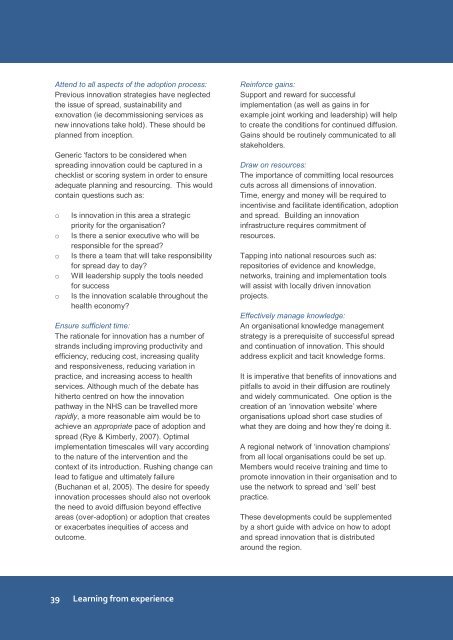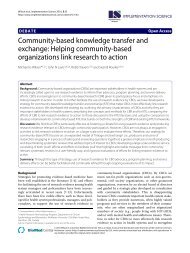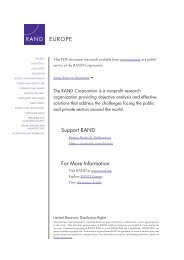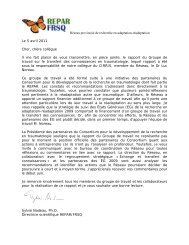Promoting and Embedding Innovation
Promoting and Embedding Innovation
Promoting and Embedding Innovation
Create successful ePaper yourself
Turn your PDF publications into a flip-book with our unique Google optimized e-Paper software.
Attend to all aspects of the adoption process:<br />
Previous innovation strategies have neglected<br />
the issue of spread, sustainability <strong>and</strong><br />
exnovation (ie decommissioning services as<br />
new innovations take hold). These should be<br />
planned from inception.<br />
Generic „factors to be considered when<br />
spreading innovation could be captured in a<br />
checklist or scoring system in order to ensure<br />
adequate planning <strong>and</strong> resourcing. This would<br />
contain questions such as:<br />
o<br />
o<br />
o<br />
o<br />
o<br />
Is innovation in this area a strategic<br />
priority for the organisation<br />
Is there a senior executive who will be<br />
responsible for the spread<br />
Is there a team that will take responsibility<br />
for spread day to day<br />
Will leadership supply the tools needed<br />
for success<br />
Is the innovation scalable throughout the<br />
health economy<br />
Ensure sufficient time:<br />
The rationale for innovation has a number of<br />
str<strong>and</strong>s including improving productivity <strong>and</strong><br />
efficiency, reducing cost, increasing quality<br />
<strong>and</strong> responsiveness, reducing variation in<br />
practice, <strong>and</strong> increasing access to health<br />
services. Although much of the debate has<br />
hitherto centred on how the innovation<br />
pathway in the NHS can be travelled more<br />
rapidly, a more reasonable aim would be to<br />
achieve an appropriate pace of adoption <strong>and</strong><br />
spread (Rye & Kimberly, 2007). Optimal<br />
implementation timescales will vary according<br />
to the nature of the intervention <strong>and</strong> the<br />
context of its introduction. Rushing change can<br />
lead to fatigue <strong>and</strong> ultimately failure<br />
(Buchanan et al, 2005). The desire for speedy<br />
innovation processes should also not overlook<br />
the need to avoid diffusion beyond effective<br />
areas (over-adoption) or adoption that creates<br />
or exacerbates inequities of access <strong>and</strong><br />
outcome.<br />
Reinforce gains:<br />
Support <strong>and</strong> reward for successful<br />
implementation (as well as gains in for<br />
example joint working <strong>and</strong> leadership) will help<br />
to create the conditions for continued diffusion.<br />
Gains should be routinely communicated to all<br />
stakeholders.<br />
Draw on resources:<br />
The importance of committing local resources<br />
cuts across all dimensions of innovation.<br />
Time, energy <strong>and</strong> money will be required to<br />
incentivise <strong>and</strong> facilitate identification, adoption<br />
<strong>and</strong> spread. Building an innovation<br />
infrastructure requires commitment of<br />
resources.<br />
Tapping into national resources such as:<br />
repositories of evidence <strong>and</strong> knowledge,<br />
networks, training <strong>and</strong> implementation tools<br />
will assist with locally driven innovation<br />
projects.<br />
Effectively manage knowledge:<br />
An organisational knowledge management<br />
strategy is a prerequisite of successful spread<br />
<strong>and</strong> continuation of innovation. This should<br />
address explicit <strong>and</strong> tacit knowledge forms.<br />
It is imperative that benefits of innovations <strong>and</strong><br />
pitfalls to avoid in their diffusion are routinely<br />
<strong>and</strong> widely communicated. One option is the<br />
creation of an „innovation website‟ where<br />
organisations upload short case studies of<br />
what they are doing <strong>and</strong> how they‟re doing it.<br />
A regional network of „innovation champions‟<br />
from all local organisations could be set up.<br />
Members would receive training <strong>and</strong> time to<br />
promote innovation in their organisation <strong>and</strong> to<br />
use the network to spread <strong>and</strong> „sell‟ best<br />
practice.<br />
These developments could be supplemented<br />
by a short guide with advice on how to adopt<br />
<strong>and</strong> spread innovation that is distributed<br />
around the region.<br />
39 Learning from experience
















